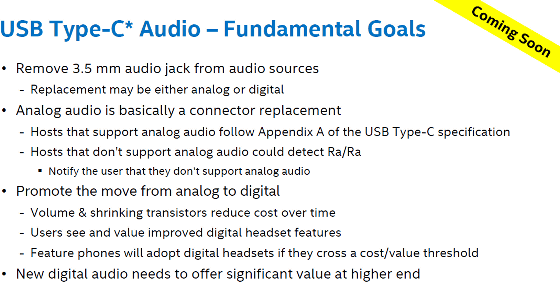Intel is developing a new standard to eliminate smartphone's earphone jack and make USB Type-C replace audio cable

ByTechStage
Following the origin of the earphone plug used to listen to music on a smartphone will arrive at the connection plug of the telephone exchange used in the 19th century. Although it is an earphone with a 3.5 mm "mini jack" plug with a background of more than 100 years history, Intel is developing specifications to use the latest USB type-C cable as audio cable. Developers Forum held by Intel in Shenzhen, China on 13th and 14th April 2016 "Intel Developer Forum 2016 - Shenzhen(IDF 16) "Intel mentioned the digital type audio connector" USB Type-C Digital Audio "which replaces the conventional analog earphone jack.
Intel Proposes to Use USB Type-C Digital Audio Technology
http://www.anandtech.com/show/10273/intel-proposes-to-use-usb-typec-cables-to-connect-headsets-to-mobile-devices
The image interface has already been shifting from the analog type VGA to the digital type HDMI, while the traditional analog method has been used deeply with respect to the audio interface. This is natural because the sound itself is pure "analog", but all data is processed digitally inside the computer, whereas in the stage of signaling to the outside analog All the merit as data will be lost by converting it.
In addition to the data handling point of view, there is a need to separately install dedicated chips that physically process the audio analogue and connectors dedicated to audio. This will occupy a large part literally in the evolution of smart phones, which are becoming more compact and slimmer on the main body, realizing the USB Type-C Digital Audio which makes it possible to save space by using a common connector is inevitable It seems to be said that it can be said that it is said.

When USB Type-C Digital Audio is realized, in the future the mini-jack disappears from the smartphone and portable music player, and the day when the connection with the earphone and the headset will all use the USB Type-C connector may come Hmm. If so, the audio signal will be transmitted just beside the ear while being digitized, it will be converted to analog just before the speaker and delivered to the ear drum's eardrum. The merit of nearly complete digitization is that it makes it easier to use headphones that can surround playback by solving the problem of noise mixing and impedance caused by analog cable and digitally transferring multi-channel audio It seems that points etc may be mentioned. There is also the advantage that electricity can be supplied together using the USB Type-C cable.

Nonetheless, it may be necessary to understand that this is not the first time for standardization to integrate audio interfaces into USB cables. In the early 2000s, Motorola tried to integrate charging, data transfer, and audio output by mounting a Mini USB connector on feature phone (Garaké). However, at that time, the corresponding headset and other products were too few, so it did not reach full-scale dissemination. The key to popularizing audio cables using USB Type-C seems to depend on how many products appear and become common.
Intel plans to make the USB Type-C Digital Audio standard in the second quarter of 2016. It has already been put into the marketUSB Audio Class 2.0It is said that we are working on updating the standards and coping with them, and we expect that the list of compatible devices will be announced in the future.
Related Posts:







